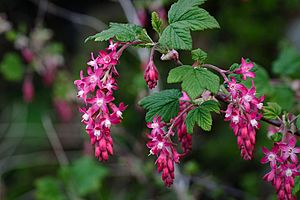Flowering currant facts for kids
Quick facts for kids Flowering currant |
|
|---|---|
 |
|
| Scientific classification | |
| Genus: |
Ribes
|
| Species: |
sanguineum
|
| Synonyms | |
|
|
Ribes sanguineum, often called the flowering currant or red-flowering currant, is a lovely plant found in North America. It's a type of flowering plant that belongs to the Grossulariaceae family. This plant naturally grows in the western parts of the United States and Canada, including British Columbia, Washington, Idaho, Oregon, and California. However, because it's so beautiful, people now grow it in gardens all over Europe and Australia too!
Contents
What it Looks Like
The flowering currant is a deciduous shrub, which means it's a woody plant that loses its leaves every autumn. It can grow quite large, reaching up to 2 meters (about 6.5 feet) tall and just as wide.
Its bark is a dark brownish-grey color, with lighter brown spots called lenticels that help the plant breathe.
The leaves are usually 2 to 7 centimeters (about 1 to 3 inches) long and wide. They have a special shape called "palmate," meaning they look a bit like an open hand with five main parts or lobes. When the leaves first appear in spring, they have a strong, fresh, resin-like smell.
The flowers are one of the best parts of this plant! They bloom early in spring, right when the new leaves start to grow. The flowers hang in clusters called racemes, which are about 3 to 7 centimeters (about 1 to 3 inches) long. Each cluster can have anywhere from 5 to 30 small flowers. Each flower is about 5 to 10 millimeters (less than half an inch) across and can be a beautiful red or pink color.
After the flowers, the plant produces small, dark purple, oval-shaped berries. These berries are about 1 centimeter (less than half an inch) long. You can eat them, but they don't have a very strong taste.
The second part of the plant's scientific name, sanguineum, comes from Latin and means "blood-red." This name perfectly describes the plant's bright, colorful flowers!
Different Types of Flowering Currant
There are a few different types, or varieties, of Ribes sanguineum. Here are two common ones:
Plant Health
Sometimes, Ribes sanguineum can be affected by a plant disease called white pine blister rust. This disease can harm the plant.
Growing Flowering Currant
The flowering currant was first brought into gardens in the 1800s by a Scottish botanist named David Douglas. Since then, it has become a very popular plant for gardens. People love it because of its bright, colorful, and often sweet-smelling flowers that bloom early in spring. It's also great for supporting birds and providing them with a place to live.
Gardeners have chosen many different types of flowering currants, with flowers that can be white, pink, or even very dark red. Some of these special types have even won awards, like the Royal Horticultural Society’s Award of Garden Merit. A few of these award-winning types include:
- 'Koja'
- 'Poky's Pink'
- 'White Icicle' (also known as 'Ubric')
Gallery
See also
 In Spanish: Ribes sanguineum para niños
In Spanish: Ribes sanguineum para niños








